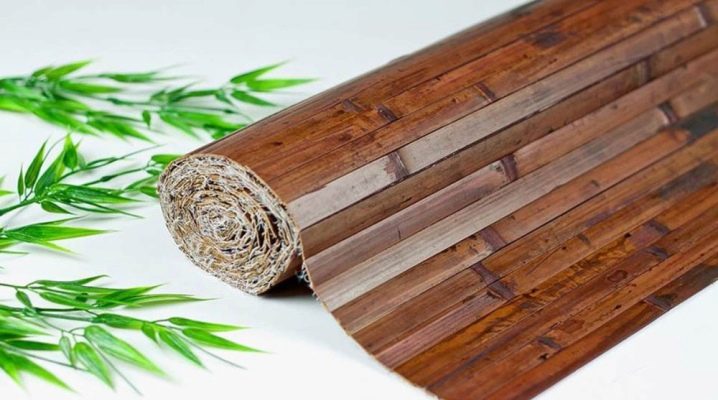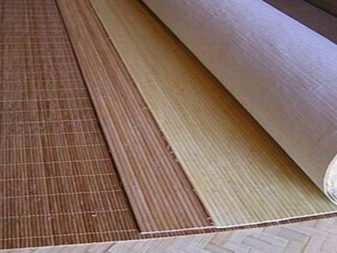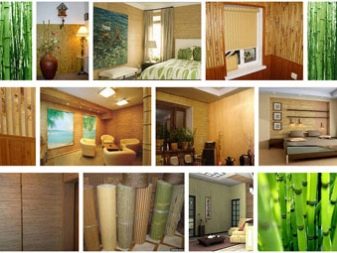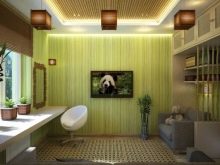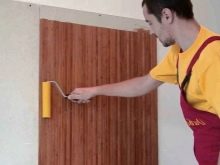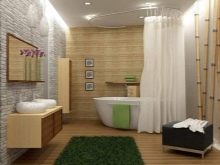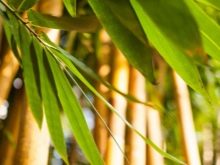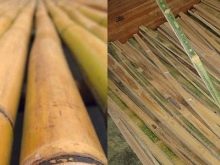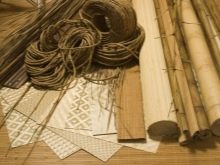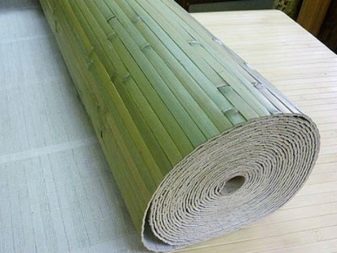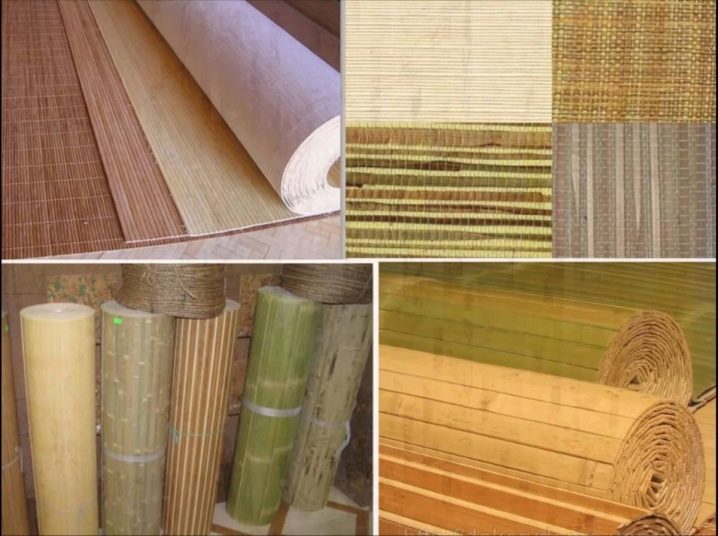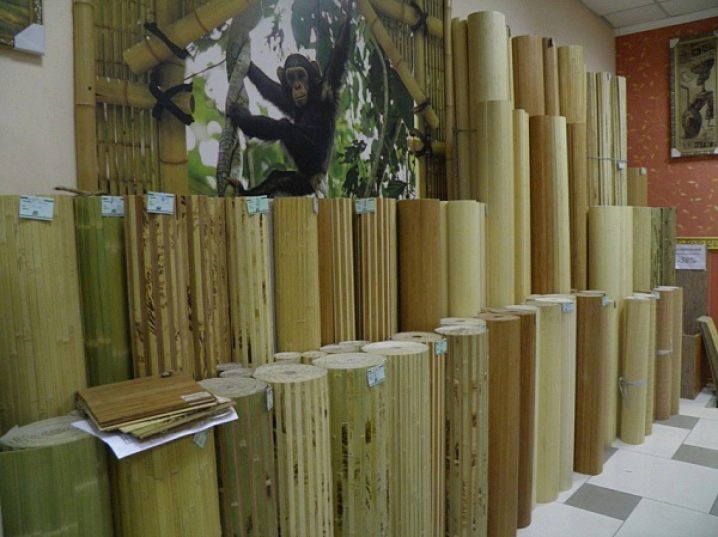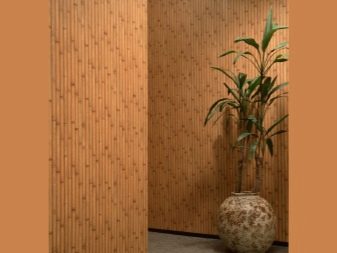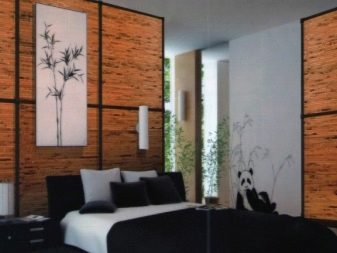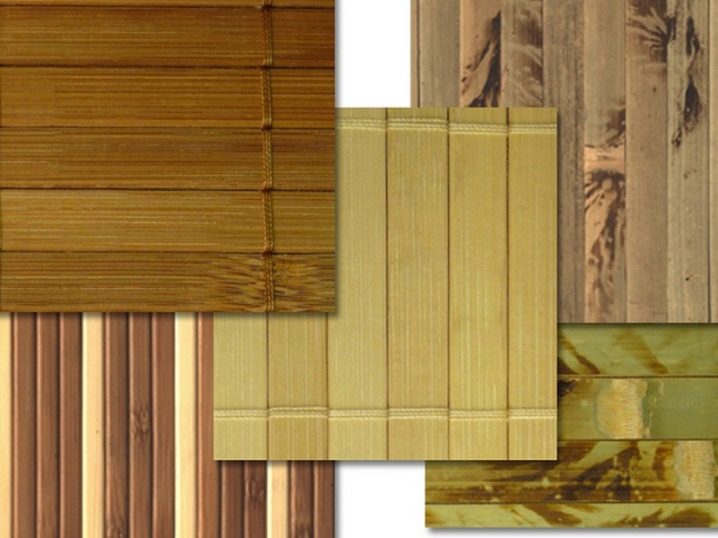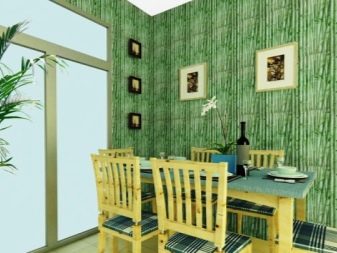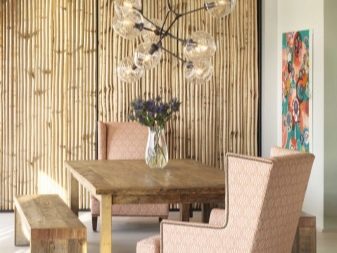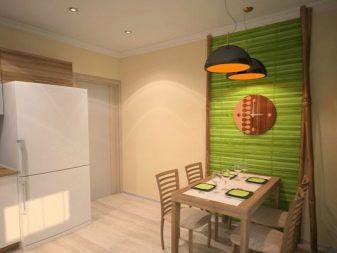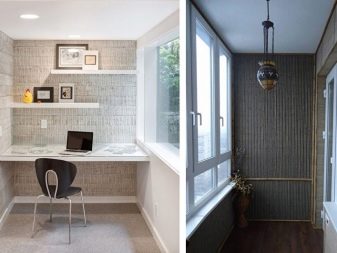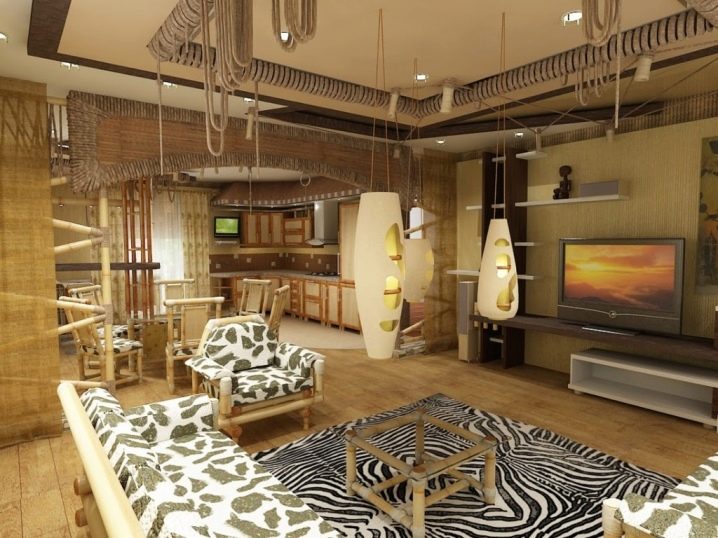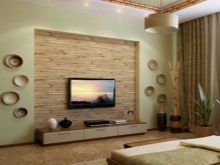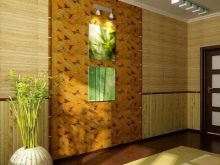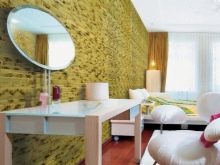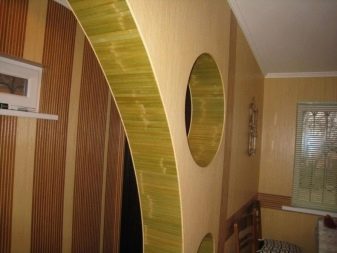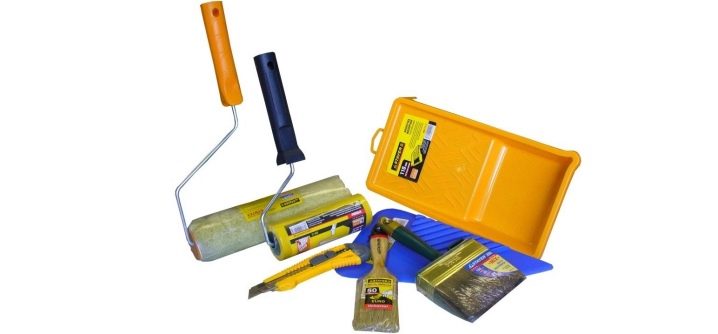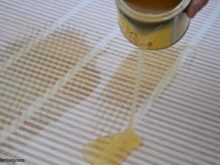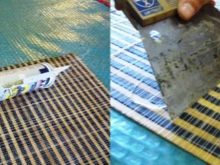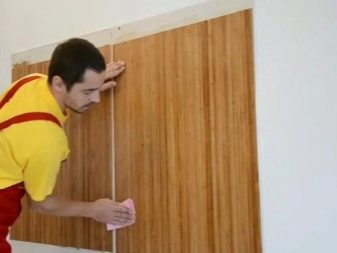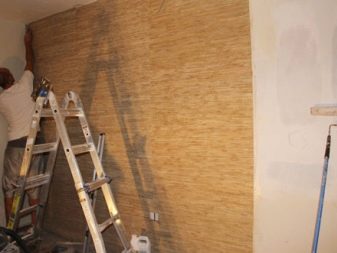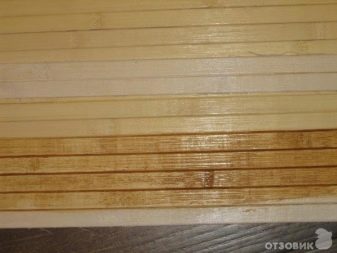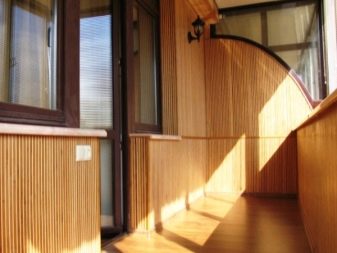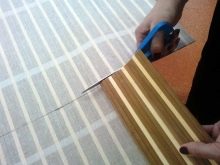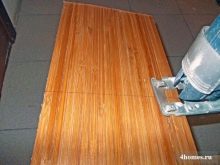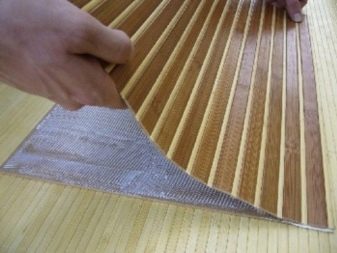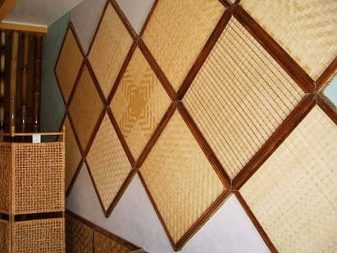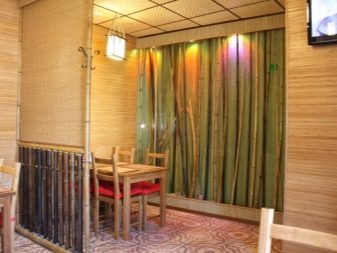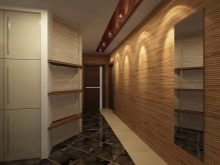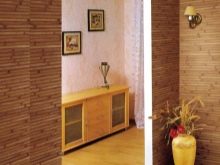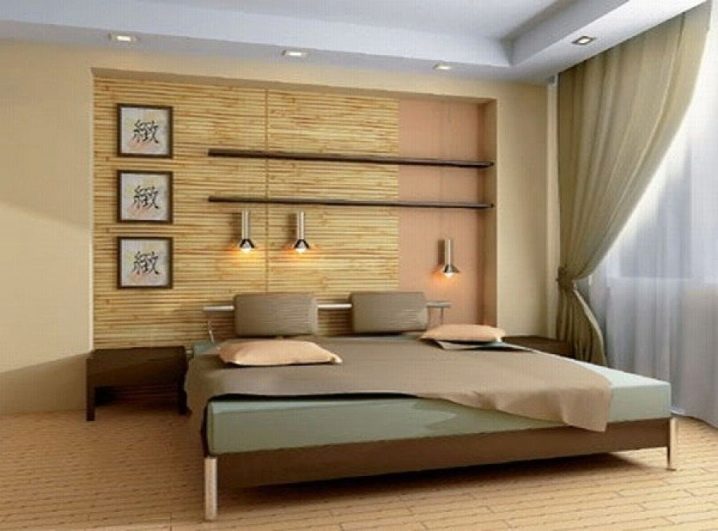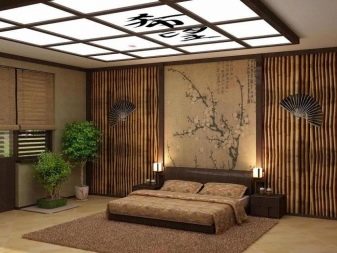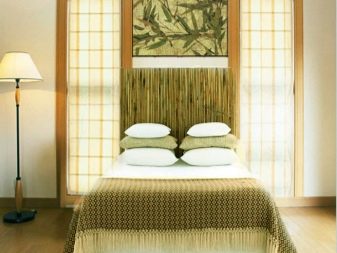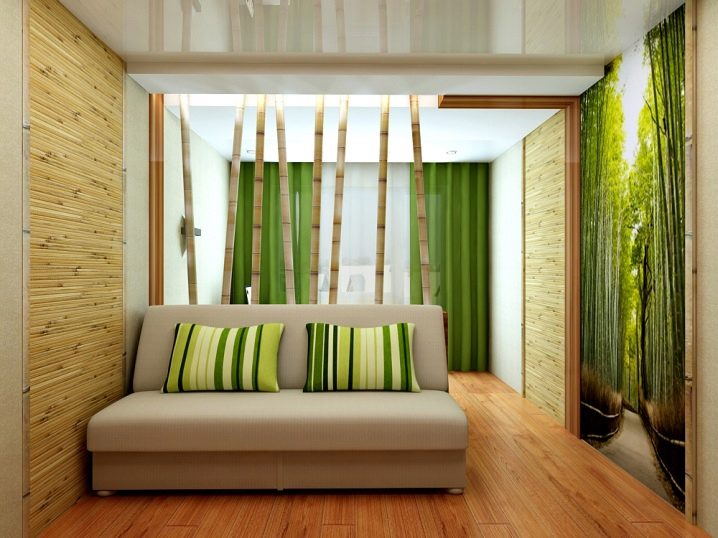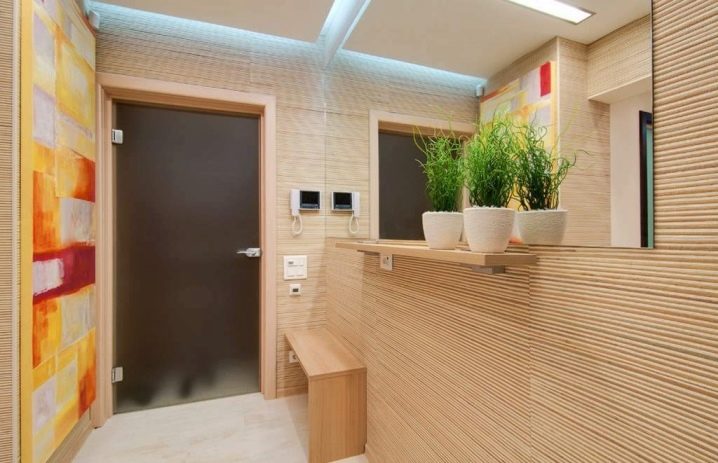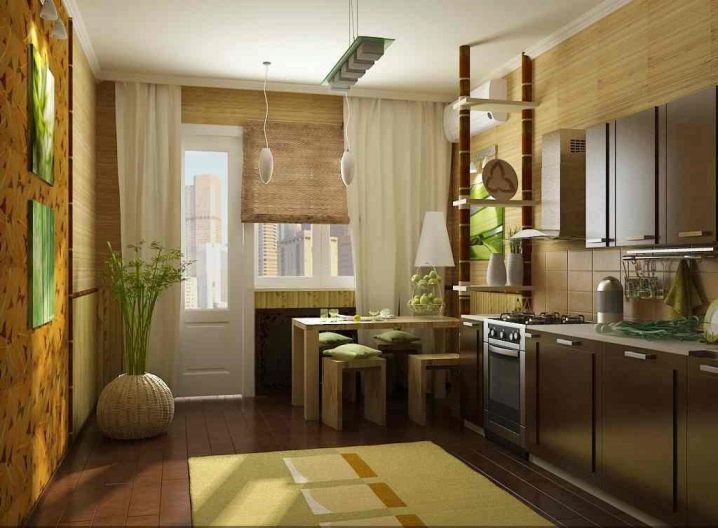Bamboo wallpaper: features
Modern interior design to use natural materials. For popular areas of eco-design, Provence, country, minimalism, Japanese style is the best fit natural wall coverings made of bamboo wallpaper. A variety of natural colors and textures, environmental friendliness and aesthetic appearance provide high demand for natural wallpapers.
Advantages and disadvantages
Natural wall-paper will decorate an interior and will emphasize design of the room of any style, having made emphasis on environmental friendliness of design. Bamboo wallpapers have undoubted advantages:
- Environmentally friendly material - bamboo wallpapers are made from natural materials, do not cause allergies.
- Beautiful nature texture - for one batch of wallpaper, the bamboo stalks are selected for one variety, manufacturers carefully select bamboo slats of the appropriate texture and shade.
- Wide color palette - the color of bamboo slats depends on the place of growth of the plant, the time of collection, the temperature regime of the initial drying, therefore the color palette of wall coverings can be from soft white to rich brown shades.
- Ease of care and anti-static - the coating does not attract and does not absorb dust. Sometimes manufacturers cover the slats with antistatic impregnation, which facilitates the process of caring for the coating.
- Long service life - high-quality wallpaper with the technology of fastening will last up to 10 years, since the material is not subject to fading when hit by the rays of the sun, has anti-vandal properties.
- Hide the bumps in the wall - due to the dense structure and thickness of the wallpaper can hide minor defects and irregularities, and, therefore, do not require perfect alignment of the walls.
- Glued to various surfaces - You can glue on wood, putty, plastic, cement and other surfaces, using only a primer and the necessary type of glue or liquid nails.
The disadvantages of bamboo wallpaper include the following aspects:
- High price - natural materials go through a series of labor-intensive and energy-intensive stagesdrying and preparation for use, which causes their high cost.
- Difficulty attaching to the wall - Wallpaper sticking should take place in stages, following the manufacturer's recommendations. It is better to entrust such hard work to a professional.
- A boring kind of total gluing rooms in one type of coating - designers do not recommend to glue the walls in one type of wallpaper. Bamboo is better to use as panels in the room or create decorative panels, combining with cork coating or other types of wallpaper.
- Surface roughness - on the surface of bamboo slats, bumps and seals of the structure may occur. Such defects are not considered a marriage, but can complicate the process of joining seams and sticking.
When choosing bamboo wallpaper as a room decoration, you should consider the pros and cons of this finishing material. Designers and craftsmen recommend using them in the hallway, living room, hallway, kitchen.
This type of wall covering is permissible to use in any living room and non-residential premises (offices, reception rooms, cafes) to maintain an environmentally friendly interior and create an atmosphere of comfort and warmth.
Manufacturing technology
Bamboo contains a large percentage of moisture (up to 80%), so for the manufacture of high-quality and durable wall coverings, raw materials undergo a long process of processing.
For the production of wallpaper is used only the young part of the shoot stem. The drying process is divided into two stages:
- the stems are tapped in a room with a constant temperature and humidity of about 45%. This moisture provides strength and elasticity of the material and does not allow it to crack from the rapid loss of moisture.
- the raw material is finally dried in the warehouse.
The drying process is one of the most responsible. Depending on the temperature and speed of drying, bamboo changes its color and shade. After it, the stem splits into the upper and inner parts, which are straightened under slight pressure and glued to the base of the future roll of wallpaper. The width of the bamboo slats can vary from 5 to 25 mm. The basis can be fabric or paper. When gluing using glue on a natural basis.
The finished wall covering is available in rolls of standard sizes with a width of 1, 1.5, 2 m. Less commonly, rolls of 2-2.5 m wide are found in stores.Sometimes wallpaper is produced not in rolls, but in sheets, ready for pasting in the form of panels in the room. Sheet panels are fragile and require special transportation and storage conditions, but this type of finish is immediately ready for gluing and does not require time for leveling.
In the process of wallpaper production, only natural materials are used. For an additional decor, they apply the slats with the base of the wallpaper with a contrasting or textured thread along the edges of the canvas. The surface retains the natural airing of the wall covering, and the overall color is selected by selecting each element for tone and texture.
Kinds
The types of bamboo wallpaper are differentiated by the materials of the bamboo trunk, which is used to cover:
- From the outer part of the bamboo trunk.
- From the inside of the trunk.
On the outer layer is clearly visible tree structure. Such wall coverings have a more dense structure and resemble bamboo columns when gluing wallpaper slats vertically. Imitation of bamboo stalks visually increases the room, adds volume to the space and height of the room.
The outer layer is different texture, unique pattern and color.The color of the upper layer is non-uniform, which gives the surface volume and depth. These types of wallpaper do not cover varnishes and paints, while maintaining the natural look.
Reiki wallpaper, which removed the top layer, or rather matched by color. For greater practicality, manufacturers lacquer wallpaper. The lacquered surface is moisture resistant and easy to clean.
For greater practicality, wallpaper slats can be stitched with decorative thread along the edges. The firmware not only provides additional mounting on the base, but is also an additional decorative element in the design of the room.
Colour
The color of bamboo wallpaper depends on many factors. The color of the finished canvas of natural wallpaper is affected by:
- Plant variety.
- Place of growth.
- Stalk cutting time.
- Temperature and humidity of the initial stage of drying.
Natural bamboo wallpapers are presented in the following colors:
- Shades of white - white, ivory, emerald, milk, etc.
- Green - bright and juicy shades of green will bring spring mood to any room. Pale green, spring grass color, green-brown, pistachio hues are the most common colors of bamboo leaves.
- Beige - there are rare colors with pink and peach, yellow and honey shades.
- Brown - natural colors of bamboo slats have shades from light brown and coffee with milk to rich brown.
How to choose?
Decor with natural wallpaper in rolls begins with the definition of the area of pasting: full pasting of the room or the use of bamboo panels. The number of rolls should be taken with stock and from one batch.
Natural wallpaper is often used in eco-design, so designers recommend combining the color of bamboo wall coverings with the color of furniture, floor, veneer doors and window frames.
On the balcony, loggia, terrace, bamboo finish should be organically combined in color with wicker rattan furniture.
Designers recommend supporting the natural wall covering with additional accessories: straw blinds, young bamboo shoots in a glass vase, and textiles with a natural print.
Reviews of interior owners, made of natural materials, indicate that the total wrapping of bamboo wallpaper on a fabric or paper-based wallpaper looks quite boring and reduces the visual space. And designers, and homeowners who are not indifferent to the interior design of their homes agree,that panels of bamboo wallpaper, framed by moldings, or a combined panel of bamboo wallpapers and cork panels look dynamic and stylish in the interior of any style.
Finish
Bamboo wallpapers are used to decorate not only walls, but also arches, balconies, loggias, etc. The natural wall covering is glued to any surface: concrete, wood, brickwork, plastic.
Bamboo wall covering is quite dense and can hide minor surface irregularities, so you can do without the perfect preparation of the walls. However, the surface must first be cleaned of the remnants of the previous coating, sanded, treated with an antifungal solution and allowed to dry well.
When pre-processing can not use aggressive agents that, in contact with the wallpaper may discolor them.
Tools for decorating walls with bamboo wallpaper:
- Wide brush for uniform glue application.
- Plastic spatula for additional fixation of the edges of the wallpaper.
- Rubber roller for smoothing and pressing the canvas against the wall.
- Knife with small teeth, a hacksaw, a jigsaw for cutting wallpaper webs.
Stages pasting:
- Leveling the canvas: the day before, the wallpaper should be turned on a flat surface and allowed to lie down.
- Cutting the canvas: cut the roll into pieces of the desired size and shape.
- Applying glue: glue is applied on the wall and on the reverse side of the wallpaper. At the same time, the edges of the wallpaper are treated with a thicker layer, the excess of which is removed in the process of pasting with a damp cloth or a special solution. After application, it is necessary to allow the surface to soak well for 6-10 minutes. It is impossible to bend, fold the bamboo cloth, since the bends irrevocably deform the cloth and will remain visible when gluing.
- Pasting: a piece of wallpaper is carefully pressed against the wall with a rubber roller. The edges are pressed with a plastic spatula. Wet rag removes residual glue at the joints.
For finishing it is impossible to use glue on a water basis. Each wallpaper pack contains the recommended types of glue that should be considered. When decorating arched openings, rooms of irregular shape with a large number of corners, the bamboo leaf should be cut at the joints of the outer and inner corners.
When glue becomes impregnated with bamboo, it becomes much harder, so you can use decorative nails for additional fixation. Irregularities of the edge can be corrected with the help of decorative baseboards or moldings made of plaster, solid wood, plastic.
At observance of the steps of pasting and recommendations on the wallpaper packaging, not even craftsmen can stick the bamboo covering at home.
Painting
Wall coatings from the inside of the trunk are varnished at work or at home to protect against moisture and dirt, as well as to facilitate the process of care.
Painting bamboo fabric is possible at the discretion of the buyer. When painting, some properties of wallpaper are partially lost. The texture of the rails becomes less noticeable, and the natural play of color acquires a uniform paint color.
Most often, the coloring of the surface of bamboo wallpaper is resorted to during the restoration of the wall covering.
Painting and varnishing are suitable for protecting bamboo slats from moisture, dirt in the bathroom, kitchen, hallway, on open terraces, balconies, and loggias.
How to cut?
Dense bamboo slats are much more difficult to cut than regular wallpaper.For cutting bamboo cloth, you can use a wallpaper knife with fine teeth, a hacksaw or a jigsaw.
Cutting bamboo wallpaper along the rails can be a very sharp knife. It is carried out carefully along the rails, completely cutting the fabric or paper base.
When creating a figured panels to cut across the rails can only be saw on wood or jigsaw. The electric fretsaw will allow you to achieve perfectly smooth edges and will be able to cut the most intricate shapes according to a preliminary pattern. During the work with it cutting of a cloth is conducted on the face.
From the accuracy of cutting depends on how invisible will be the wallpaper joints and the final aesthetic look.
Is it possible to wash?
In order for the bamboo wall covering to last as long as possible, retaining the original look, certain care is required. Some manufacturers cover cloth antistatic impregnation, which repels dust. The main part of bamboo wallpaper is made without processing and any coatings.
Bamboo wallpapers should not be washed with water or detergent. Periodically, the canvas must be vacuumed, especially in the corners of the decorative moldings, where most of the dust accumulates.In some cases, for wet cleaning, you can use a damp cloth with a soft broom that will not damage the surface of the coating and will not leave lint on it, as well as non-aggressive detergents in an aerosol that do not require rinsing.
Bamboo wallpaper in high-end areas (corridor, hallway, kitchen), it is better to cover with transparent varnish.
Options in the interior
Comfort and beauty add bamboo wallpaper in the bedroom. It is easy to fall asleep in such a room, forces are quickly restored due to the natural materials and calm natural colors.
The design of the bedroom in the Japanese style will be an indispensable attribute bamboo panel at the head of the bed. It will be a worthy addition to the white walls and rice panels framed by massive wooden slats.
The eco-style living room is supported by individual sandy-beige panels. Such discreet wallpaper will serve as a base for decorative bright elements in the room (pillows, a screen made of natural bamboo stalks, photo wallpaper).
Laconic and discreet high-tech kitchen will look cozy and homely against the background of walls with bamboo coating.
The classic traditional use of sheets in the design of the hallway of an apartment or house.The totally pasted walls of the hallway with bamboo wallpaper do not look boring thanks to the mirrors and furniture in a minimalist style made of natural wood.
For how to stick bamboo wallpaper, see the next video.
